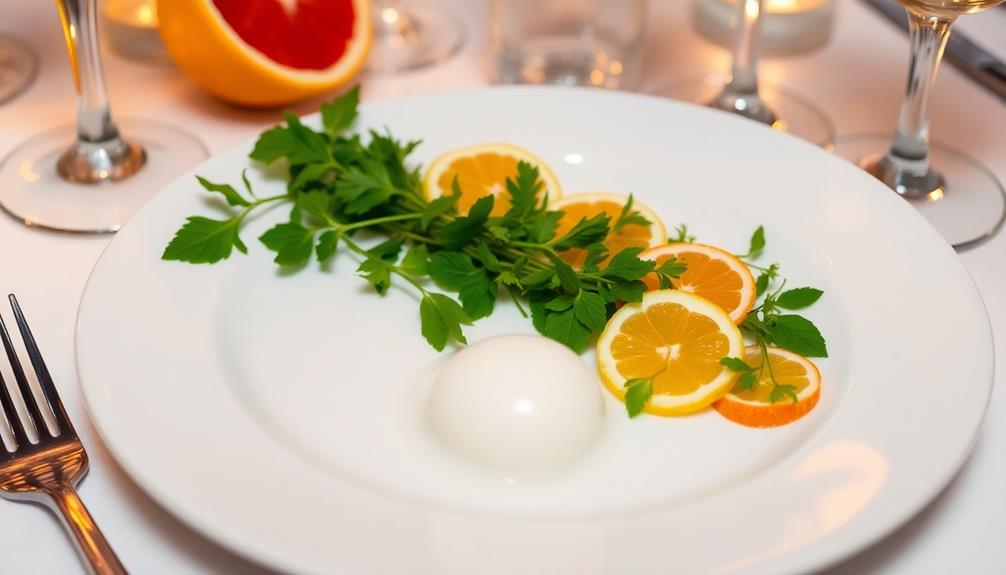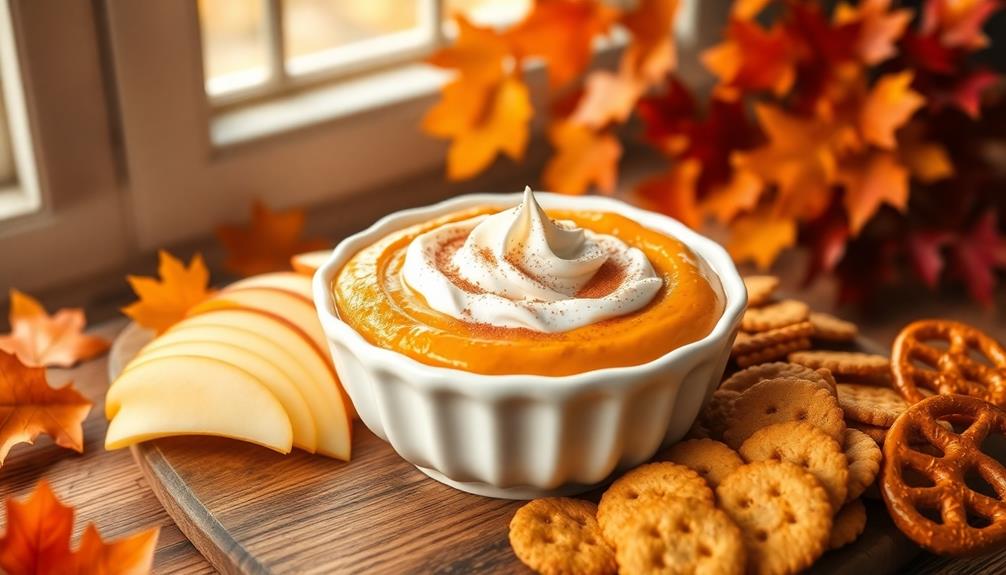In fine dining, palate cleansers act like reset buttons for your taste buds. They neutralize lingering flavors, helping you to fully enjoy each dish. Common choices include sorbet, sparkling water, and even pickled vegetables, each designed to awaken your senses. These cleansers reduce palate fatigue, stimulate saliva production, and enhance your capacity to detect subtle flavors. By timing their introduction perfectly—often after rich dishes—chefs create a smoother shift to the next course. As you explore further, you'll uncover the artistry behind selecting the ideal palate cleanser for a memorable dining experience.
Key Takeaways
- Palate cleansers neutralize lingering flavors, resetting taste buds for enhanced appreciation of subsequent dishes in fine dining.
- Options like sorbet stimulate saliva production, which increases taste bud sensitivity and flavor perception.
- The temperature of palate cleansers affects taste; colder options numb while warmer ones invigorate the palate.
- Effervescent drinks, such as sparkling water, are particularly effective in reducing bitterness and cleansing the palate between courses.
- Strategically timed palate cleansers stimulate appetite and create balanced shifts between savory dishes and desserts.
Definition of Palate Cleansers
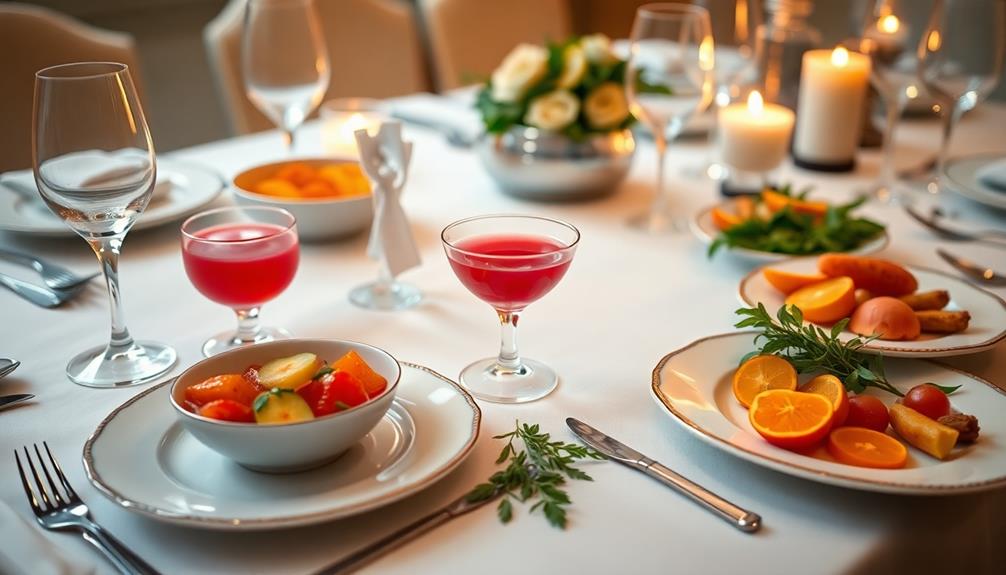
When you think about fine dining, palate cleansers play a significant role in enhancing your experience. These rejuvenating bites or sips are designed to reset your taste buds between courses, preventing flavor overlap and allowing you to fully appreciate each dish.
In a multi-course meal, palate cleansers serve to neutralize lingering flavors that could interfere with the intricate tastes of subsequent courses. This concept can be likened to the careful balance of flavors in dishes like Nettle and Potato Soup, where the freshness of ingredients is paramount for an enjoyable experience.
Common options for palate cleansers include sorbet, plain crackers, sparkling water, and citrus fruits. Each choice successfully revitalizes your palate and prepares you for the next culinary delight.
The timing of serving these palate cleansers is essential; they're typically offered after rich or strong-flavored dishes and before moving on to dessert. This guarantees a smooth progression of flavors, enhancing your overall dining experience.
The science of taste also plays into the importance of palate cleansers, as they help reset your sensory receptors, allowing for a more nuanced appreciation of upcoming flavors. This is especially important in tastings or multi-course meals, where the goal is to fully experience each distinct dish. Additionally, palate cleansers can also help to highlight different taste profiles, such as why cultures prioritize bitter flavors as a way to balance out other dominant flavors in their cuisine. This practice allows for a more harmonious and well-rounded dining experience. For example, in some cultures, bitter flavors are highly valued for their medicinal properties and ability to aid digestion. As a result, palate cleansers that incorporate bitter elements can complement and enhance the overall dining experience. By understanding the science behind taste and the cultural significance of different flavor profiles, chefs and food enthusiasts can create more well-balanced and thoughtful culinary experiences. This is also why cultures prioritize bitter flavors in their cuisine, as they provide a depth and complexity that enhances the overall enjoyment of a meal.
While palate cleansers vary culturally, each reflects local ingredients and culinary practices, making your dining experience not only delicious but also an exploration of different culinary traditions.
Types of Palate Cleansers
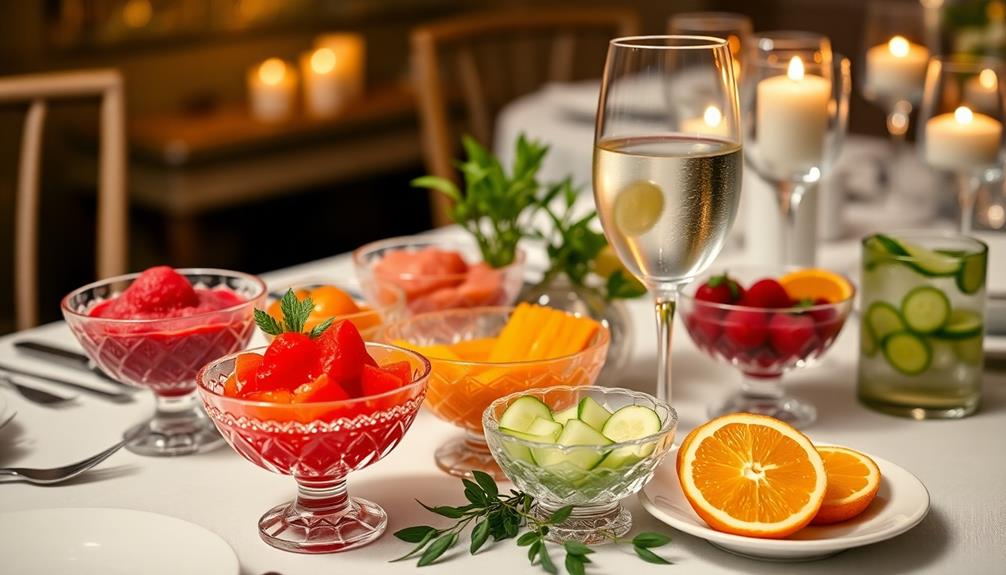
The variety of palate cleansers available in fine dining showcases the creativity and thoughtfulness that chefs put into enhancing your culinary experience.
For instance, dishes like Red-Braised Pork Belly can leave a rich flavor on the palate, making palate cleansers essential for resetting your taste buds. Common palate cleansers include sorbet, a frozen dessert often made with citrus fruits, which refreshes the palate with its bright flavors.
Plain crackers or bread serve as neutral options, absorbing lingering tastes to help cleanse your palate effectively. Sparkling water stands out for its effervescence, which physically cleanses the palate and helps neutralize flavors between courses.
Natural citrus fruits like lemons or limes provide a zesty, invigorating option that targets dryness and enhances your overall tasting experience.
Another intriguing choice is pickled vegetables, whose tartness offers a sharp contrast that resets your taste buds, making each bite of the next dish feel fresh.
Additionally, herbal teas, known for their light and aromatic qualities, can aid digestion and refresh the palate, allowing you to fully appreciate the nuances of each course.
In fine dining, these palate cleansers not only enhance your meal but also reflect the chef's dedication to delivering a remarkable culinary journey.
Benefits of Palate Cleansers
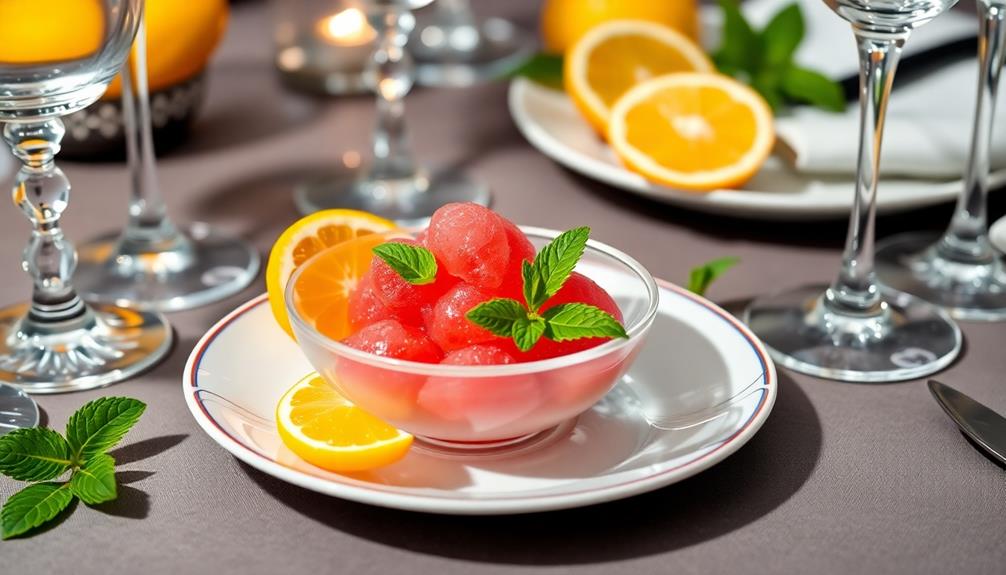
Palate cleansers enhance your flavor perception, making each dish stand out in a multi-course meal.
They can be inspired by various global culinary experiences, such as the revitalizing zing of a citrus-based dish like ceviche or the invigorating taste of a traditional Asian soup.
By revitalizing your palate, they stimulate your appetite for what's next, ensuring you enjoy every bite.
This strategic use of palate cleansers not only elevates your dining experience but also creates a seamless shift between flavors.
Flavor Perception Enhancement
To truly savor the diverse flavors of a multi-course meal, incorporating palate cleansers is essential. These effective palate cleansers, such as sorbet or sparkling water, help cleanse the palate by neutralizing lingering flavors from previous dishes. This process enhances your flavor perception, allowing you to fully appreciate the unique tastes of each course without interference.
For instance, a rich dish like Mushroom Masala can leave a lingering earthiness, making a palate cleanser even more vital.
By using palate cleansers, you can reduce palate fatigue during lengthy dining experiences. This keeps you engaged and ready to detect even the subtlest flavors that might otherwise be masked. Furthermore, these invigorating and revitalizing options stimulate saliva production, further enhancing taste bud sensitivity and overall flavor enjoyment.
Cleansing the palate between courses creates a balanced shift, particularly essential before dessert. This technique emphasizes sweetness without the distraction of savory dishes that came before.
Research shows that effective palate cleansers, like acidic fruits or effervescent beverages, can greatly elevate your overall dining experience. By incorporating these elements, you'll discover that each course shines in its own right, transforming your meal into a delightful exploration of flavors.
Appetite Stimulation Techniques
Incorporating palate cleansers during a meal not only refreshes your taste buds but also sharpens your appetite for what's next. These palate cleansers, like sorbet or sparkling water, stimulate saliva production, which enhances your appetite by priming your taste buds for the upcoming flavors.
Just as a well-prepared dish, such as Agnolotti, can showcase regional flavors, a palate cleanser can highlight the distinctiveness of each course. By using palate cleansers between courses, you can prevent palate fatigue, keeping your enthusiasm high throughout a multi-course dining experience.
When you choose palate cleansers that are acidic or effervescent, you invigorate your taste perception, making each subsequent dish more appealing and flavorful. Research shows that these cleansers effectively reset taste sensations, ensuring that flavors don't overlap and allowing you to remain engaged and excited for your next course.
Strategic timing is key; serving palate cleansers after rich or heavy dishes can stimulate your appetite for lighter or sweeter options, like desserts. This thoughtful approach maximizes your dining experience, ensuring that each course is savored and enjoyed.
How to Serve Palate Cleansers
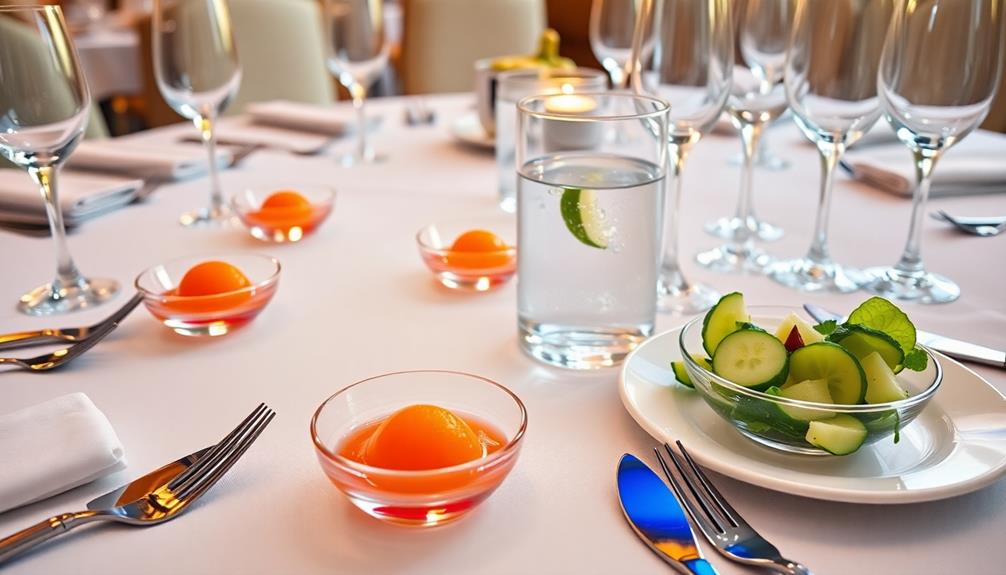
When you're ready to serve palate cleansers, keep in mind that chilling them beforehand truly enhances their revitalizing quality.
Consider incorporating flavors inspired by Brazilian cuisine, such as coconut or citrus, to elevate the experience. Serve your palate cleansers in small portions to avoid overwhelming the taste buds and to maintain the flow of the meal. This allows your guests to appreciate the shift between courses without feeling stuffed.
To optimize flavor shifts, consider pairing your palate cleansers with specific courses. For example, a rejuvenating citrus sorbet after a rich main course can cleanse and prepare the palate for dessert. Using seasonal ingredients not only elevates freshness but also showcases your culinary creativity and connection to local flavors.
Presentation matters too. Serving palate cleansers in visually appealing ways, such as shot glasses or unique dishes, can enhance the overall dining experience.
This attention to detail creates memorable moments for your guests, making the meal more enjoyable. By thoughtfully selecting and presenting your palate cleansers, you'll guarantee that they serve their purpose effectively, leaving diners invigorated and ready for the next course.
The Science of Flavor Reset

Palate cleansers play an essential role in fine dining by resetting your taste buds, ensuring each course shines with its unique flavors. The science behind this reset focuses on how these cleansers neutralize lingering taste molecules and stimulate your sensory experience. For instance, flavors from dishes like Dorayaki (Red Bean Pancake) can linger on the palate, making it critical to cleanse before moving to the next course.
Here's how they work:
- Neutralization: Palate cleansers wash away residual flavors, allowing your taste buds to reset for the next dish.
- Acidity and Saliva: Options like sorbet not only cleanse but also stimulate saliva production, enhancing your ability to perceive new flavors.
- Temperature: The temperature of palate cleansers affects your taste experience; cold items can numb your taste buds, while warm beverages invigorate them.
Understanding these interactions is essential in elevating your appreciation of diverse flavors.
Studies show that effervescent palate cleansers, such as sparkling water, can notably reduce bitterness in subsequent tastes. This fascinating science behind palate cleansing helps you fully enjoy each course during your culinary journey, making it a critical aspect of fine dining.
Experimenting With Palate Cleansers

Exploring the world of palate cleansers opens up a domain of possibilities for enhancing your dining experience. To truly cleanse the mouth and reset your taste buds between courses, you can experiment with different options like sorbets, sparkling water, or even pickled vegetables.
For an intriguing twist, consider incorporating flavors from traditional Indonesian desserts like Kue Putu, which features the richness of coconut and palm sugar, or a revitalizing touch of pandan from Dadar Gulung. These common palate cleansers help separate flavors from the previous dish, allowing you to fully appreciate the next one.
You might find that pairing citrus with seafood or enjoying herbal teas after rich courses considerably enhances your flavor experience.
Don't hesitate to experiment with different, unconventional palate cleansers, such as infused waters or herbal infusions. These unique choices can lead to delightful discoveries that elevate your meal beyond traditional norms.
Culinary Applications and Techniques
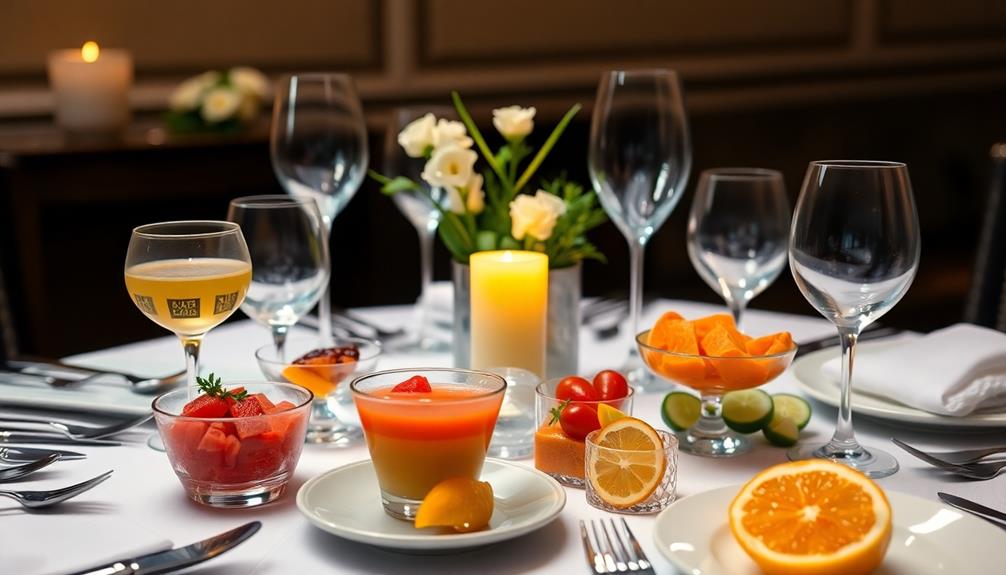
In fine dining, the art of palate cleansing is essential for a memorable meal. You'll find that effective palate cleansers reset your taste buds, allowing you to fully appreciate each dish's unique flavors. Here are three culinary techniques to elevate your dining experience:
1. Cold and Acidic Options: Sorbets infused with citrus not only provide a revitalizing contrast but also neutralize residual flavors effectively. Their cold temperature enhances the cleansing effect.
Additionally, incorporating elements like Ethiopian salads can offer a vibrant freshness that complements the cleansing process.
2. Herb Infusions: Incorporating fresh herbs like mint or parsley invigorates the palate. These herbs introduce bright, aromatic notes that stimulate your senses and prepare you for the next course.
3. Effervescent Choices: Sparkling water adds a fizzy quality that physically cleanses the mouth. Its acidity helps cut through richer dishes, making it an ideal palate cleanser.
The presentation of these palate cleansers is just as important. Elegant glassware or unique serving methods can transform a simple course into a visually stunning experience.
Frequently Asked Questions
What Is Palate Cleanser in Fine Dining?
A palate cleanser in fine dining refreshes your taste buds between courses. It prepares you for new flavors, preventing any lingering tastes from previous dishes. Common options include sorbet, sparkling water, or citrus fruits.
Why Are Palate Cleansers Important?
Think of your taste buds as a symphony; palate cleansers act as the conductor, invigorating your senses. They're essential for savoring each dish, preventing flavor fatigue, and ensuring every bite remains a delightful experience.
How Do Sommeliers Cleanse Their Palate?
Sommeliers cleanse their palate by sipping sparkling water, swishing it around, or munching on neutral foods like bread or unsalted crackers. This keeps their taste buds refreshed, ensuring they accurately perceive the next wine's flavors.
What Is Palate Cleanser in Food Industry?
You might think palate cleansers are unnecessary, but they're essential in the food industry. These invigorating bites or sips prepare your taste buds for new flavors, enhancing your overall dining experience and appreciation for each dish.
Conclusion
In the world of fine dining, palate cleansers are your secret weapon for a remarkable culinary experience. Think of them as a revitalizing pause in a symphony of flavors, allowing each dish to shine on its own. By understanding their role and experimenting with different types, you can elevate your dining adventures. So, next time you sit down for a meal, don't overlook these delightful interludes; they're not just optional, they're essential for savoring every bite!
